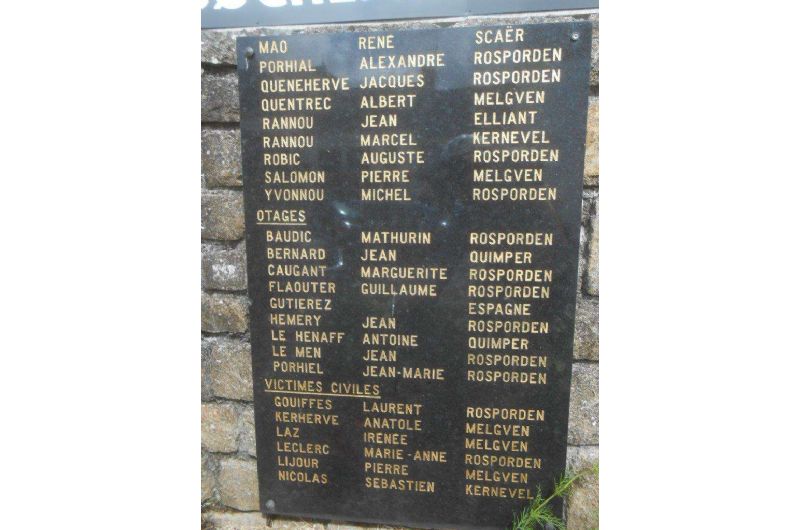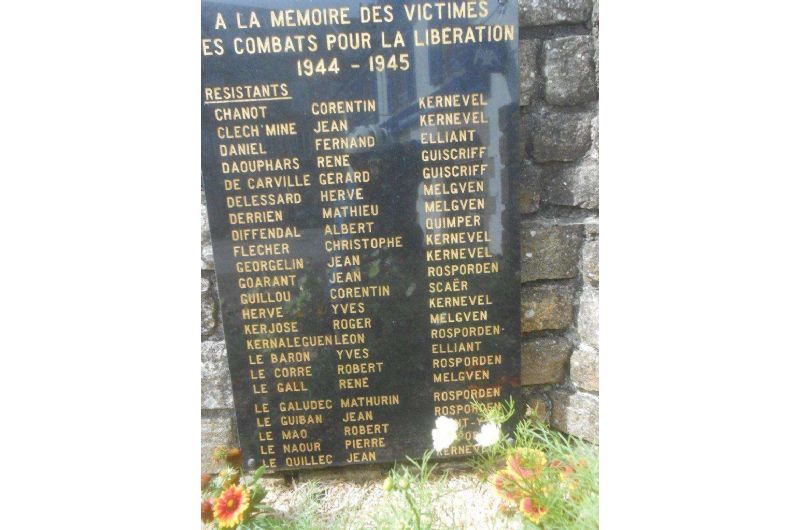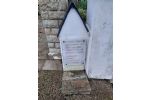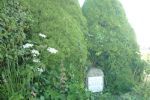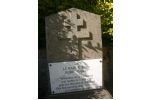Memorial to the victims of Rosporden
- 12
- See on map
Memorial to the victims of the fighting for the Liberation of Rosporden.
On August 2, 1944, the Mercier battalion, hidden since July 28, 1944 in the Kerodet farm in Coray (its base is named "camp Delessart" in homage to one of the resistance fighters shot at Kernabat-Quillien), receives via a coded message from London radio ("Is Napoleon's hat still in Perros-Guirec?") the order to take Rosporden. At the time, American troops were still in Pontorson, 280 km away. The town was liberated between August 4 and 6, 1944; fighting began on August 4, 1944 and lasted all day, Robert Ricco managing to hoist the tricolor flag over the town hall; the resistance fighters withdrew in the evening, leaving the Germans still in control of the town. The Germans, along with some White Russians who were staying in the Sainte-Thérèse school, then took reprisals against the population, robbing, raping and setting fire to thirty-two houses. Some twenty-five people, almost all from the Pont Biais district, were taken hostage and taken to Quimperlé, including the mayor of Tourch, René Le Roy. The train taking them from Quimperlé to Lorient was bombed at Quéven (Morbihan) on August 7, 1945, and the hostages then tried to escape; nine of them were killed: Marguerite Caugant (née Le Naour), Vincent Baudic, Jean Bernard, Jean Flaouter, Jean Hémery, Antoine Hénaff, Jean Le Menn, Albert Pirlo, Jean-Marie Porhiel.
The insurrection begins again on August 5, 1944 at 5am. A train from the organisation Todt was stationed that night at Pont Biais (in the immediate vicinity of Rosporden station), and the Germans there reinforced the German resistance. A group of FTP resistance fighters, led by Jean Goarant, known as "Perrochet", was hooked by the Germans on August 5, 1944 at Poteau Vert, on the road from Rosporden to Concarneau : the fighting leaves four Resistance fighters dead (Jean Goarant, 41; Yves Hervé, 31; Jacques Quénéhervé, 2; Jean Le Quilliec, 23). Resistance fighters attack the local kommandantur, which was based in the house of miller Caugant. The Mercier battalion's official entry into liberated Rosporden was celebrated in the early afternoon of August 5.
On August 6, 1944, German troops coming from Brest and seeking to retreat towards the Loire were stopped at the western entrance to Rosporden at Dioulan by the platoon of Lieutenant Gérard de Carville, mortally wounded in the fighting during which René Daouphars, a Resistance fighter from Guiscriff, was also killed, along with Jean Clech'mine, from Kernével. The Germans are forced to turn back and take refuge in Concarneau. In all, the Germans have twenty-three trucks out of action and around three hundred killed and wounded; nine trucks are recovered by the Resistance fighters.
Other Resistance fighters killed during the fighting for the liberation of Rosporden are Jean Le Guiban on August 5, 1944 and Pierre Le Naour, from Rosporden; Auguste Robic, from Melgven.
On August 7, 1944, a group of resistance fighters from the Vengeance movement attack German soldiers at Kernaoulan in Nizon and seek to prevent a possible German attack from the German cantonments of Le Fresq and Kerguirizit in Melgven: Yves Trichard is killed that day by a German explosive bullet at Croissant-Bouillet.
Rosporden was the scene of war crimes committed by the Germans, but also by Rospordinois: a few days after the town's liberation, in retaliation for the atrocities committed by German and White Russian troops, local Resistance leaders had German soldiers taken prisoner in Riec-sur-Bélon and totally uninvolved in these exactions handed over to them [insufficient source]. One soldier was shot without trial in each house burnt down, the youngest of whom was under 18. The bodies left abandoned were recovered by the American army, who gave them a decent burial.
Two Resistance fighters were mayors of Rosporden at the Liberation: Albert Rivier (appointed president of the special delegation on August 10, 194479), then briefly René Gall.
The General de Gaulle came to Rosporden, hard hit during the Libération of France, on July 22, 1945. He also stopped off at La Croix-Lanveur (commune of Kernével at the time), where he was greeted by the Kernével commune authorities and the population of the village and surrounding area.
Source Wikipedia
Photo credit and contribution Philippe Boudot.
Source Wikipedia


